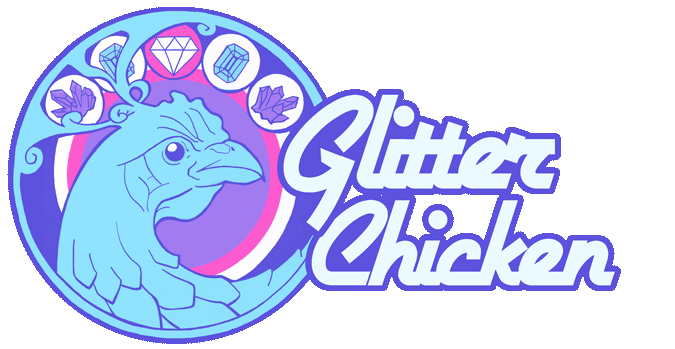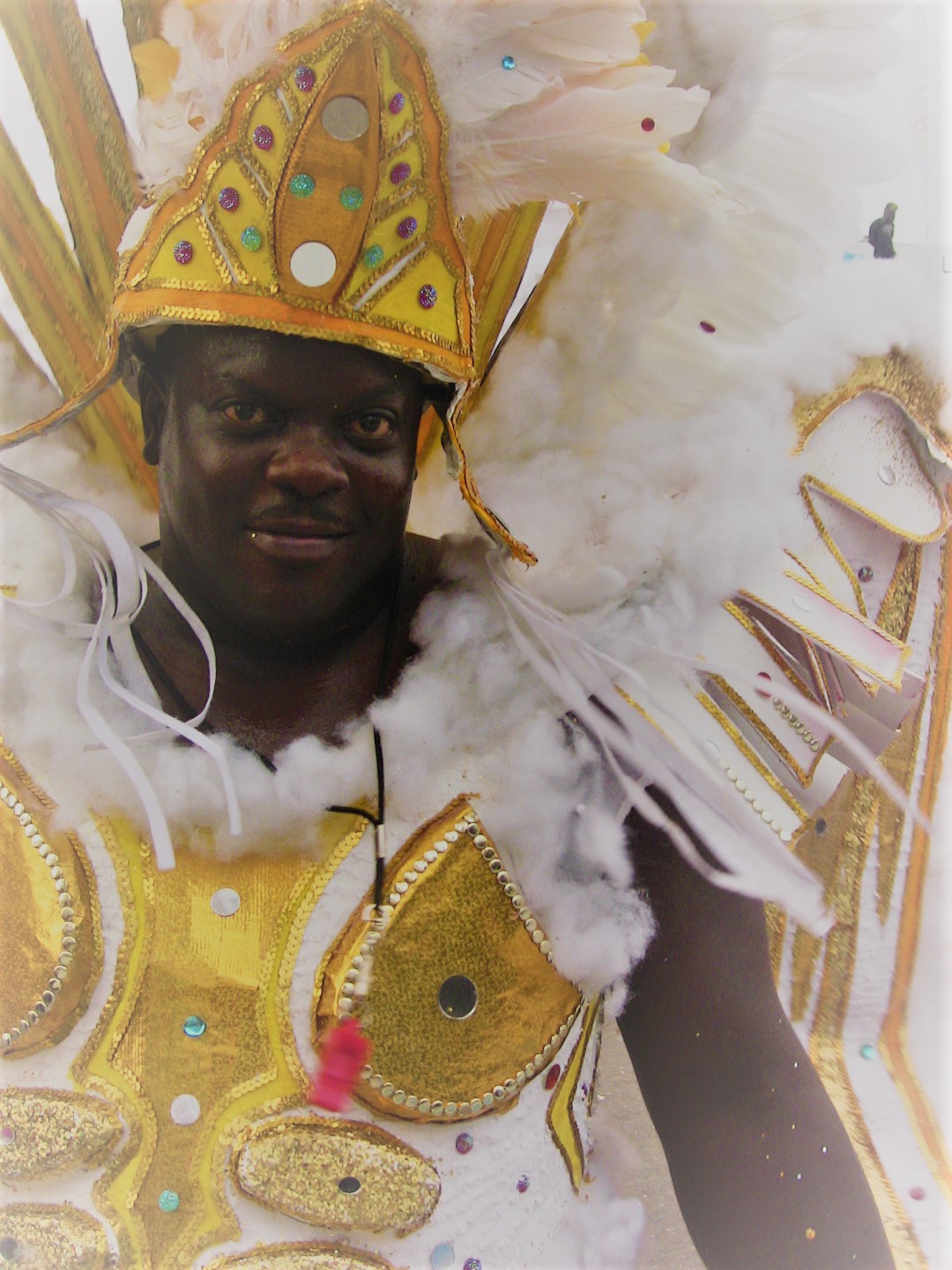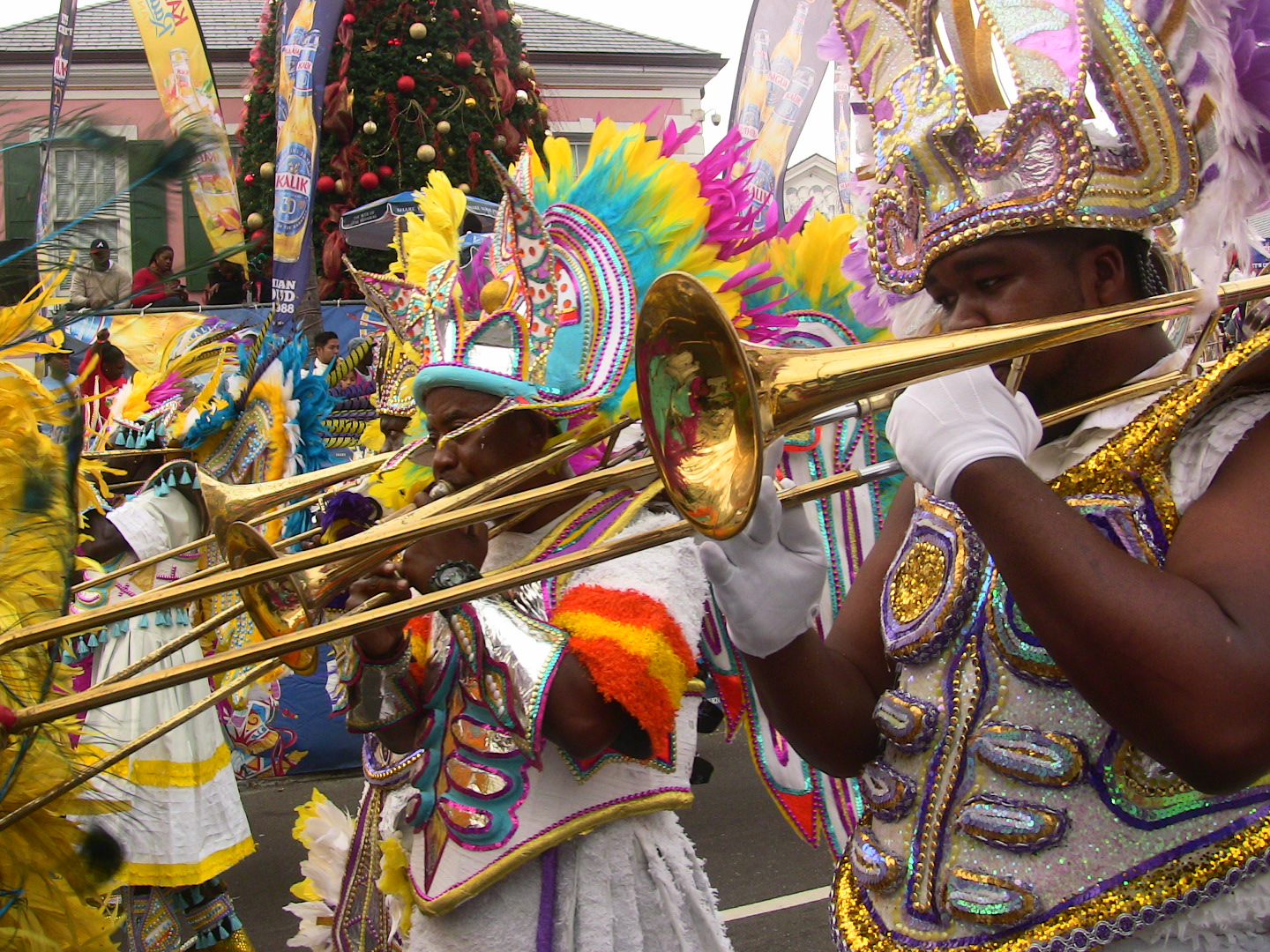Junkanoo
The main streets in downtown Nassau were blocked off to traffic along the parade route, so my taxi driver dropped me where West Bay Street curves behind the historic British Colonial Hilton hotel. The sidewalks were literally covered with bejeweled feathered backpieces and headdresses, musical instruments, and people sitting around all decked out in brightly colored attire. Not wanting to trip over anything or anyone, I gingerly tiptoed into the road. Whoosh! An enormous float rolled past my left shoulder, festooned with huge papier-mâché heads emerging from the windows of a souped-up Mercedes Benz. Whoosh! On my right, a gigantic Blue Marlin striped with orange, gold, and blue sequins swam by, carried overhead by two men. “Stand back!” people shouted, to ensure that nobody got impaled on the fish’s spear-like bill. “That was kind of them,” I thought, as I ducked and sidestepped to the left.
A warm feeling of confidence bubbled up inside me. I had wanted to fully experience the Junkanoo parade in Nassau – I had been told that there’s nothing like it in the world – that’s the reason why I had flown down to the island of New Providence in the Bahamas on Christmas Day and taken a taxi downtown at 3:00 am on December 26th (Boxing Day).[1] I hadn’t anticipated being part of the parade, but I was starting to get the hang of this bobbing and weaving thing. I was standing in what was essentially the “backstage” area where the Junkanoo groups were preparing for their performance in front of the judges and throngs of excited spectators lining Bay Street, many of whom had been out here since the official start of the parade the night before. Hoping to get out of the street and seek out an ideal viewing spot, my eyes searched for a small opening in the barricades to slip through, but my view was blocked in every direction by feathers of every shape, size, and color.
“Get out of the way!” people shouted. And then the sky darkened. Whatever was coming down the street behind me was of such gargantuan proportions that it blocked the light streaming down from the streetlamps. Half expecting to see Godzilla, I turned around to face a float that looked like a multi-layered cake for newlywed giants decorated with humongous parrots sprouting from all 4 corners of each layer. Taking up the entire street, it forced us all against the barricades, putting the parrots in prime position to carry out a murderous rampage. The beaks of the birds at street level were aimed directly at our heads, which required everyone to do the limbo or die. Who would have known that all those crazy backbends I’ve been doing in yoga class would one day save my life?[2] The parrots at the 2nd story level were busy trying to peck out the eyes of the spectators on the balconies and take down some electric wires and railings while they were at it. I didn’t stick around long enough to find out if there were any casualties. Recognizing the face of a compassionate man who had helped people get out of the path of the killer parrots, I asked him where I could find an opening in the barricade and followed his directions to the letter.
Whew! Finally out of the street, I felt safer, but still didn’t know where to go to get a good view. The road was well lit in front of the Straw Market; I took out my digital camera to adjust the flash. Suddenly, the crowd parted, and people directed me up to the front row so that I could get a good shot. This was a refreshing change from what I was accustomed to in the U.S., where people in the front row of a parade route refuse to budge an inch from “their” spots and won’t even let little kids in. It was my first true indication as to how deeply Bahamians feel about Junkanoo; they’re remarkably proud of their culture and super enthusiastic about sharing it with visitors.[3]
From its origins in the celebration that occurred when slaveowners granted their slaves a 3-day holiday at Christmastime, Junkanoo has evolved into the most authentic surviving expression of Bahamian cultural heritage.[4] After having been colonized by the British until 1973, Junkanoo is the Bahamian umbilical cord to Mother Africa; the fiery-plumed costumes worn by the dancers and the syncopated rhythms emanating from the musicians’ goatskin drums and cowbells bear tribute to their African ancestry.[5]
Doubtful that I had managed to capture the essence of this colorful spectacle with my camera, the couple standing next to me introduced me to a lovely British Airways flight attendant who was also seeking out an ideal viewing location; they suggested that we head back to Woodes Rogers Walk and circle around back to Bay Street and then inch our way into the grandstands.[6] On our way, not far from where the cruise ships were docked, a young man approached us – not to sell us anything or ask us for money or harass us in any way – just to give us his personal opinion as to which beaches on the island were best, which we genuinely appreciated.
Fortunately, my new travelling companion had the sunniest disposition this side of the equator and an engaging personality to boot, so we made our way into the grandstands in no time after entertaining the guard lady who mistook us for sisters. From my new vantage point, it didn’t take me long to realize that there’s far more to Junkanoo than cultural preservation; it also demonstrates an ardent devotion to craft and crew. My taxi driver had already told me that members of the major Junkanoo groups – Genesis, Music Makers, the Saxons Superstars, the Valley Boys, the Prodigal Sons, Roots, and One Family – spend all year in their workshops tirelessly constructing the massive floats and intricate costumes that all fit together into a single theme. But there was no way I could have imagined the astounding level of artistic expression I was witnessing. Showering the crowd with $100 bills (which we quickly snatched up even though we knew they were fake), the Valley Boys mocked humanity’s love affair with money and fame, lampooning celebrities and world leaders such as Queen Elizabeth and President Trump. Paying homage to the Christian faith at the foundation of Bahamian society, Roots reminded us that “heaven is real” with angels, demons, miracles, and prophetic visions.[7]
During the long break between groups, we made the brilliant decision to visit the food vendors behind the grandstands. To our surprise and delight, we could buy a serving of freshly fried conch fritters (the island specialty) for only $3.00 accompanied by a side of fried plantains for only $2.00 and 2 traditional desserts called peanut cake and benny (sesame seed) cake for $2.00 each; they weren’t really cakes, but rather homemade candy patties, like peanut brittle only harder. We shared and enjoyed everything immensely.
The street food was especially appetizing when washed down with the local brew called Kalik, which I purchased for $5.00 from a young man tending a makeshift bar who was thrilled to teach me all about the guys on the back of the Bahamian currency. Admittedly, I didn’t have high expectations; I popped open the can expecting a tasteless swill, but I was pleased to discover a medium-bodied golden lager with a refreshing bite, not unlike Yeungling.
When we got back to the grandstands, I realized that the Commonwealth Brewery, the manufacturer of Kalik, was an official sponsor of the Junkanoo parade. Blue banners advertising Kalik were hanging all over the judges’ platforms and the parade marshals were giving away cans of Kalik to the winners of trivia contests and foot races who had been pulled out of the crowd to entertain weary spectators during breaks between groups. Successful marketing has made Kalik almost symbolic of Junkanoo; it’s been said that the beer’s name was derived from the distinctive sound of the cowbells.[8]
Despite the omnipresence of Kalik, I observed very little public drunkenness at the Junkanoo parade. A few of the young men volunteering for the contests and some older men dancing to their own drumbeats in the street during the breaks may have been inebriated, but the police tolerated them,[9] maybe because nobody was getting out of hand. I can attest to the fact that the crowd at the Junkanoo parade was a remarkably well-behaved bunch. I didn’t see a single violation of the prohibition against glass bottles. I witnessed very little smoking – just the occasional cigar – and no drugs. No cursing, no lewd and lascivious gestures, and no nudity either. The centrality of religion in Bahamian culture is undoubtedly a contributing factor to the unexpectedly wholesome atmosphere, which is most likely a side effect of colonialism. After living under British rule for generations, Bahamians are accustomed to behaving like proper subjects; stiff penalties for violations of the law still serve as deterrents to crime. The result is that Junkanoo is a family friendly event, folks, not a bacchanalia.[10]
I was astounded by the number stalwart spectators still standing when the last group One Family started making their way down Bay Street around 9:00 am. A group of newcomers joined us, invigorating the grandstands with new energy. They bought a bag of roasted peanuts from a Rastafarian man and offered some to me, which I gratefully accepted. “Look, there’s my granddaughter!” exclaimed the lady left and I reached for my camera. I was beginning to see the pattern in the lineup of each Junkanoo group. Children danced on the lead float bearing the group’s name and theme, which in this case was Nursery Rhymes: The Ones We’ll Always Remember.[11] At first, I wasn’t too sure how this seemingly juvenile theme would measure up to the other groups, but then the floats started rolling in, featuring familiar characters such as the 3 Little Pigs & the Wolf, Old King Cole, and the Old Woman Who Lived in the Shoe; the crowd started calling out the verses to the rhymes almost instinctually. Then, the individual dancers in their intricately crafted costumes bounced along…and the crowd sang out as they recognized each one: ”Mary, Mary, quite contrary...Jack be nimble, Jack be quick…Little Miss Muffet sat on her tuffet…Jack & Jill went up the hill… It’s raining, it’s pouring, the old man is snoring…”
Then came the choreographed dance number that really put One Family’s performance over the top. Two groups of gorgeous female dancers – one group dressed like ballerinas and the other group dressed like Little Bo-Peep shepherdesses – undulated gracefully, interweaving and then separating into distinct lines, like shimmering silk threads in a tapestry. More floats followed the dancers, and then came the musicians – first the shakers, cowbells, whistles, and long horns – then the brass section complete with trumpets, saxophones, trombones, and sousaphones – and last but not least, the drums – big metallic oil barrels with goat or sheep skin stretched over one end – that quite possibly could wake the dead as well as sleepy spectators.
Later that evening, when everyone gathered at the Fish Fry[12] for the official announcement of the Boxing Day Junkanoo parade winners, I wasn’t surprised at all to hear that One Family came in 1st place and the Valley Boys came in 2nd place. Amid cries of joy, I overheard plenty of emotionally charged complaints, but that’s to be expected. People have invested the very fiber of their being into this event, so it’s become customary for the losers (and their fans) to cry “We’ve been robbed!” prompting the winners (and their fans) to defend their title.
As a newcomer, free from the biases that deep loyalties inspire, I can honestly say that Junkanoo is a form of communal creative expression like no other you will ever experience; from the grandstands, you can literally feel the essence of each Junkanoo group as it “rushes out” down the street. And from my perspective, One Family succeeded in their grandiose attempt to convince us that we all speak a common language, our similarities are far greater than our differences, and that we really are one giant human family - a message consistent with the group’s name. And I can’t think of a more appropriate message for Junkanoo. Because nobody is treated like a foreigner or an outsider at Junkanoo. No matter what country you’re from or what color you are, you’re respected simply for being there before the chickens wake up and you’re immediately welcomed into the celebration. You may even find yourself part of the parade. And suddenly people are saving you from killer parrots … and making room for you ... and introducing you to new friends … and feeding you peanuts. And so together, in unison, you sing nursery rhymes, the ones you’ll always remember.
[1] There are actually 2 Junkanoo parades – the Boxing Day Junkanoo parade that starts late at night on December 25th and goes on until the morning of December 26th and the New Year’s Junkanoo parade that starts on New Year’s Eve and goes on until the morning of New Year’s Day. All the locals told me that the New Year’s parade is bigger I believe them. (Bahamians seem to be very earnest people, generally) but it’s hard for me to believe how anything could be bigger than the Boxing Day parade I witnessed.
[2] To my knowledge, no one else died either. Bahamians are very flexible people, I discovered. I saw some mighty close calls, though, and fascinating physical contortions and grimaces, especially the big man standing to my left carrying a tall pole, like a king’s scepter. One of the parrots was literally on top of him and I thought for a second there he might bash the bird’s head in with his pole but instead, he just made like an accordion - sucked in his gut, tucked in his chin, and gently nudged it out of the way.
[3] It’s a good thing too because tourism accounts for more than 1/3 of the GNP and employs 2/5 of the workforce. The majority of tourists come from the U.S. and flock to the big resorts in New Providence and Grand Bahama islands in droves. The U.S. dollar is accepted everywhere on the islands as well as Bahamian currency. At the time of this writing, 1 Bahamian dollar was equivalent to 1 American dollar. For more on the Bahamian economy, see https://www.britannica.com/place/The-Bahamas/Economy
[4] For more on the history of Junkanoo, see https://www.trubahamianfoodtours.com/bahamas-special-events-and-festivals/junkanoo/. Other Bahamian islands host Junkanoo parades but Nassau’s are by far the largest, with corporate sponsors making substantial contributions in recent years.
[5] No one know for sure where the word Junkanoo originated, but it’s commonly believed to have been derived from an African chief of the Ahanta people named John Canoe who became a legend for opening up a can of whup-ass on the Europeans in the 1700s. https://en.wikipedia.org/wiki/John_Canoe
[6] Technically, you’re supposed to pay for grandstand seating but by 4:00 or 5:00 am, the stands have cleared out there’s room for newcomers to slide in.
[7] A profoundly religious country, it’s been estimated that there are more churches per capita in the Bahamas than anywhere else in the world. Baptists, Anglicans, Catholics, Methodists, and Seventh-Day Adventists are the most popular denominations, in that order. Home-grown congregations known as “over-the-hill” churches are also popular. Obeah, a form of spiritualism with African origins, is also practiced on its own or blended into Christian ritual. For more on Bahamian religious and cultural beliefs, see http://www.my-bahamas-travel.com/bahamasculture.html
[8] Of course, in our beer-soaked world, there are other varieties of Kalik to choose from. Check out https://en.wikipedia.org/wiki/Kalik
[9] Law enforcement officials in the Bahamas appear to be well respected in Nassau, where it is common to see women as well as men in smartly tailored uniforms. They’re ranked similarly to the Scotland Yard system, several levels of officers above the constables at the bottom rung. None of them are armed and only some of the officers carry billy clubs.
[10] Comparisons can be made between the Mummers parade in Philadelphia and the Mardi Gras parade in New Orleans in that you’ve got hard-working crews competing annually for prize money who make their own unique style of music as they march down the street in ornate costumes surrounded by ridiculously elaborate floats. But this is where the similarities cease. The revelry of Junkanoo is not fueled by alcohol, which gives the celebration a palpably less sleazy, less violent, and less dangerous quality - killer parrots notwithstanding.
[11] Children are an integral part of Junkanoo groups, demonstrative of the community’s commitment to pass on their legacy to the next generation. New Providence and other Bahamian islands even host Junior Junkanoo contests to further that aim. A noble goal indeed, but I’m still left wondering how everyone copes with the glaring reality that the entire event occurs past their bedtimes. Do the kids take periodic naps or are they expected to pull all-nighters like everyone else?
[12] The Fish Fry on Arawak Cay is a strip of little shacks that serve up the local catch along with libations. Initially envisioned as a local hang-out spot, prices skyrocketed when tourists started coming, and sadly, it’s deteriorating into another tourist trap. For a foodie’s perspective, see https://www.eater.com/2016/11/10/13557214/fish-fry-bahamas-nassau


